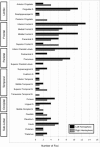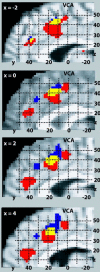A comparison of label-based review and ALE meta-analysis in the Stroop task
- PMID: 15846823
- PMCID: PMC6871676
- DOI: 10.1002/hbm.20129
A comparison of label-based review and ALE meta-analysis in the Stroop task
Abstract
Meta-analysis is an important tool for interpreting results of functional neuroimaging studies and is highly influential in predicting and testing new outcomes. Although traditional label-based review can be used to search for agreement across multiple studies, a new function-location meta-analysis technique called activation likelihood estimation (ALE) offers great improvements over conventional methods. In ALE, reported foci are modeled as Gaussian functions and pooled to create a statistical whole-brain image. ALE meta-analysis and the label-based review were used to investigate the Stroop task in normal subjects, a paradigm known for its effect of producing conflict and response inhibition due to subjects' tendency to perform word reading as opposed to color naming. Both methods yielded similar activation patterns that were dominated by response in the anterior cingulate and the inferior frontal gyrus. ALE showed greater involvement of the anterior cingulate as compared to that in the label-based technique; however, this was likely due to the increased spatial level of distinction allowed with the ALE method. With ALE, further analysis of the anterior cingulate revealed evidence for somatotopic mapping within the rostral and caudal cingulate zones, an issue that has been the source of some conflict in previous reviews of the anterior cingulate cortex.
Figures









References
-
- Banich MT, Milham MP, Atchley R, Cohen NJ, Webb A, Wszalek T, Kramer AF, Liang Z‐P, Wright A, Shenker J, Magin R (2000): fMRI studies of Stroop tasks reveal unique roles of anterior and posterior brain systems in attentional selection. J Cogn Neurosci 12: 988–1000. - PubMed
-
- Bantick SJ, Wise RG, Ploghaus A, Clare S, Smith SM, Tracey I (2002): Imaging how attention modulates pain in humans using functional MRI. Brain 125: 310–319. - PubMed
-
- Barch DM, Braver TS, Akbudak E, Conturo T, Ollinger J, Snyder A (2001): Anterior cingulate cortex and response conflict: Effects of response modality and processing domain. Cereb Cortex 11: 837–848. - PubMed
-
- Becker JT, MacAndrew DK, Fiez JA (1999): A comment of the functional localization of the phonological storage subsystem of working memory. Brain Cogn 41: 27–38. - PubMed
-
- Bench CJ, Frith CD, Grasby PM, Friston KJ, Paulesu E, Frackowiak RSJ, Dolan RJ (1993): Investigations of the functional anatomy of attention using the Stroop test. Neuropsychologia 31: 907–922. - PubMed
Publication types
MeSH terms
Grants and funding
LinkOut - more resources
Full Text Sources

